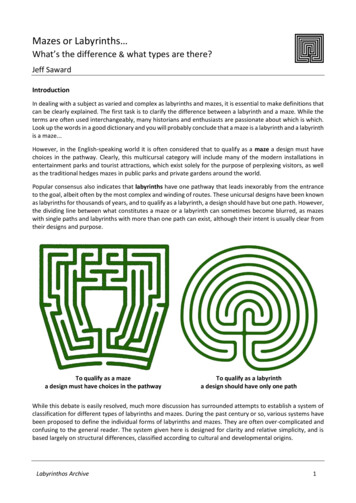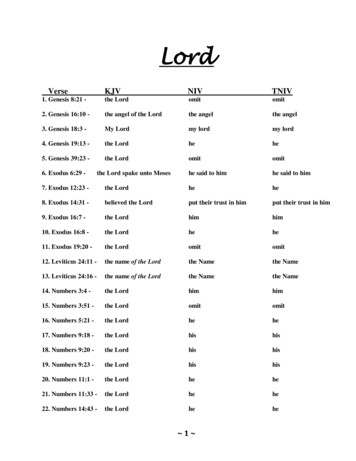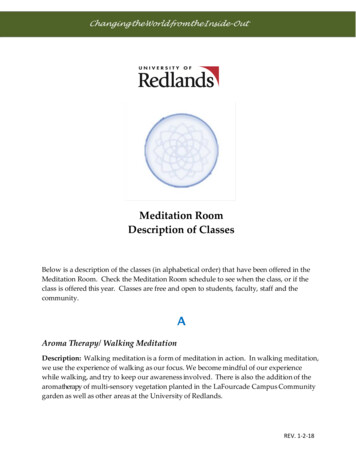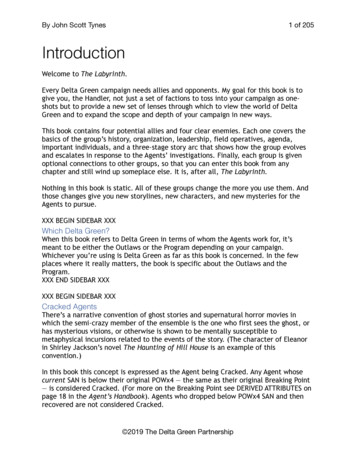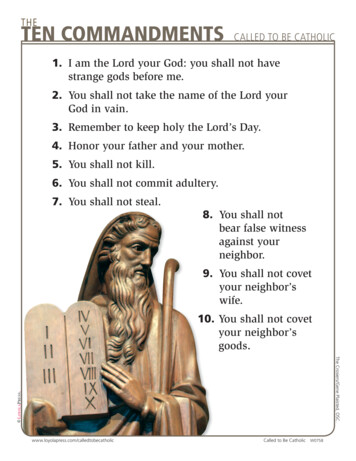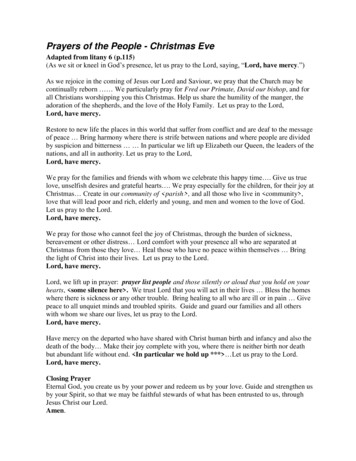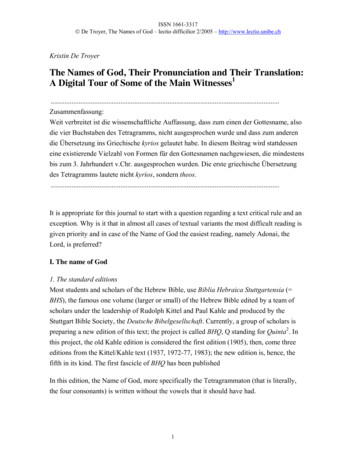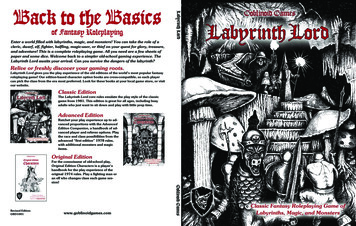
Transcription
Classic Fantasy Roleplaying Game ofLabyrinths, Magic, and MonstersBy Daniel ProctorGoblinoid Games
FOREWORDLabyrinth Lord is not new or innovative. This game exists solely as an attempt to help breathe back life into old-school fantasygaming, to do some small part in expanding its fan base. Labyrinth Lord follows in the footsteps of other „retro-clone‰ game systems.One might think of it as an emulator, meant to employ game rules (algorithms) from early 1980s games by using new presentation incombination with terms that are open game content, provided under the Open Game License Version 1.0a, by Wizards of the Coast,Inc. Labyrinth Lord is a restatement of a set of rules that are otherwise out of print and no longer commercially supported. This workfollows the idea that game rules themselves are not subject to copyright, only the specific presentation of those rules are. The goal ofLabyrinth Lord and other retro-clone systems is to make rules currently available, using a common reference, for third-party publishersto create gaming material that is not only compatible with the particular retro-clone system, but also with the system which it seeks toemulate. By doing this we hope to help build a market for games that have otherwise been allowed to fade into the past. For furtherinformation, please visit our website at www.goblinoidgames.com.This effort is meant to complement, not replace, the fine work that came before it. If Labyrinth Lord succeeds in being a goodrepresentative of old-school fantasy roleplaying, it only does so because it lies on a solid foundation. I cannot, and would not, pretendto take any of the credit.This is a game about imagination. It represents what was, for most of us, our first tentative steps into the monster-filled labyrinths ofour youth. We learned some of our first lessons about life, death, and reaching for impossible goals as we rolled strange dice we hadnever seen before, and went to worlds we otherwise would never have imagined. Old-school gaming isnÊt just about nostalgia. We goback to these game rules not just because they might be easier to learn or play compared to their modern derivatives, but also becausethere is a fresh element to the game. We open a portal to a simpler fantasy world, and we check our adult disillusionment at the door.As I enter that door I become my old dwarf character again, swinging my axe against a fresh wave of orcs on my way to defeat theevil orc chief. IÊll kill that chief and save the local village, only to fall in a battle to trolls later. But it doesnÊt matter. As long as we havethis game and our sense of wonder, the adventures never end.As I was writing Labyrinth Lord, I learned from the Internet gaming community at DragonÊs Foot (www.dragonsfoot.org) that TomMoldvay had died. He was the editor of the first set of game rules that inspires Labyrinth Lord, and his many writings made him oneof the pioneers of fantasy role-playing. Those who knew him report that he was a nice, hard-working man. I only met him through hiswritings, but it is clear that we owe him a great debt. This work is therefore dedicated to his memory.Dan ProctorJuly 2007ACKNOWLEDGEMENTSSpecial thanks are owed to Tom Moldvay, Dave Cook, Steve Marsh, E. Gary Gygax, Dave Arneson, Frank Mentzer, J. Eric Holmes,Rob Kuntz, Tim Kask, and many, many other individuals who created the foundation of fantasy role playing games. Special thanksalso to Ryan Dancey and Wizards of the Coast, Inc., for making the Open Game License and system reference documents available.This work would not have been possible otherwise. Deep appreciation is offered to Bill Ellis and Cameron DuBeers for calculatingmonster experience points, and to the community at the Goblinoid Games forums for their support and help in pointing out errata.Thanks to Trent Foster, William D. Smith Jr., Matthew Finch, Stuart Marshall, and Allen Shock for looking over this manuscript andoffering advice. The person I must thank the most is my wife, for putting up with my obsessive writing over the last many months.Dedicated to the memory of Tom MoldvayCover illustration and interior illustrations by Steve Zieser¡Layout and design by Daniel Proctor¡Editing and continuity by LavanyaProctor, Ryan Denison, and Daniel Proctor¡Copyright 2007-2009 Daniel Proctor¡Cover illustration and interior illustrationsCopyright 2009 Steve Zieser, used under license¡Labyrinth LordTM, Advanced Labyrinth LordTM, Goblinoid GamesTM, and MutantFutureTM are trademarks of Daniel Proctor¡This product is released under the terms of the Open Game License Version 1.0a,Copyright 2000, Wizards of the Coast, Inc.Revised Edition (Fourth Release)September 2009www.goblinoidgames.com
Table of ContentsTable of Contents . 3SECTION 1: Introduction . 4How to Play . 4Adventuring . 4Dice . 4Terms . 5Common Abbreviations . 5SECTION 2: Characters . 6Creating a Character: An Overview . 6Character Abilities . 6Ability Prime Requisites . 7Choosing a Class . 7Hit Points . 7Character Classes . 8Choosing Alignment. 14Character Languages . 14Character Inheritance . 14Money and Coins . 14Equipment . 15Equipment Descriptions. 16SECTION 3: Spells . 19Spell Casting Constraints . 19Saving Throws . 19Reversible Spells . 19Cumulative Spell Effects . 19Beginning Spells . 19Spell Descriptions . 20Cleric Spells. 20Magic-User and Elf Spells . 27SECTION 4: Adventuring Rules . 43Labyrinths & Monsters . 43Adventuring Groups . 43Group Organization . 43Labyrinth Rules . 44Time and Movement . 44Rest . 44Carrying Capacity and Encumbrance . 44Light and Darkness . 44Doors. 44Traps and Trap Detection . 45Wilderness Adventures . 45Time and Wilderness Movement . 45Losing Direction . 45Climbing. 46Rations and Foraging . 46Swimming . 46Air Travel . 46Water Travel. 46Hiring Retainers . 46Checking Morale . 47Retainers and Experience . 47Hiring Specialists and Mercenaries . 47Kinds of Mercenaries . 47Kinds of Specialists . 47Awarding Experience . 49SECTION 5: Encounters and Combat . 50Encounters . 50Encounters and Time . 50Labyrinth Play Sequence . 50Wilderness Play Sequence . 50Monsters Encountered . 50Movement in Encounters . 52Chases in the Labyrinth . 52Chases in the Wilderness . 52Combat . 52Combat Movement . 53Attacking . 53Unarmed Combat . 53Aerial Combat . 53Damage and Healing. 54Missile Attacks . 54Saving Throws . 54Item Saving Throws (Optional Rule) . 55Morale Checks (Optional Rule) . 56Stronghold Encounters . 56Adventures at Sea . 56Water Vessels . 56Ship Weaponry . 57Water Conditions . 57Encounters at Sea . 58Waterborne Chases . 58Waterborne Combat. 58Encounter and Combat Example . 58SECTION 6: Monsters . 61Abbreviations. 62Monster Listings . 63Wandering Monster Tables . 104Wilderness Encounter Tables . 105SECTION 7: Treasure . 106How to Roll for Treasure . 107Gems . 107Jewelry. 107Finding and Using Magic Items . 107Treasure Tables . 107Magic Item Descriptions . 110Potions. 110Rings . 113Scrolls . 114Rods, Staves, and Wands . 115Miscellaneous Magic Items . 116Weapons, Armor, and Swords . 120SECTION 8: Labyrinth Lord Lore . 123Labyrinth Design. 123Labyrinth Scenarios . 123Stocking the Labyrinth . 123Groups of NPCs . 124Wilderness Design . 125Wandering Monsters . 125Wilderness Wandering Monsters. 125Magic Research . 126Creating a Stronghold . 126Structure Prices . 127Advice for the Labyrinth Lord . 127Characters of Different Levels . 127Characters and Treasure . 127Character versus Player Knowledge . 127Impossible Tasks . 127Labyrinth Lord as Judge . 128Monsters and NPCs in Play . 128Random Rolls . 128Ruling Wishes . 128Sample Stocked Labyrinth . 128Taking it to the Next Level . 131Sample Wilderness Map . 131Index. 133Character Sheet . 134
Labyrinth LordIntroductionSection 1: IntroductionAlexandra the Elf lashes out with her sword again, but thegoblins keep getting closer. The dark pit looms behind her,the crevasse that had only moments earlier consumed hercompanion. She turns and makes a desperate leap toward thepit, hoping to land safely on the other side with the characters played by the players, but the LabyrinthLord decides on their actions, personalities, and motivations.No one in this game „wins.‰ Characters do sometimes die;this is a fact of the game, but it does not indicate failure or„losing‰ in the sense that someone loses at, say, a card game.One can measure „success‰ in this game in many ways, suchas achieving treasure, levels of experience, or powerfulmagical items. However, the one common measure of successthat everyone should strive for is to have fun. Everyone canwin at this game, because everyone can have fun playing it.So while a character may die, or riches may be lost, it is thegame play itself that matters. Winning is in being able tosuspend disbelief long enough to be immersed in a fantasyworld.You are about to enter an entirely new world. Unlike board orcard games that have highly structured play options and littleflexibility, most of the action in Labyrinth Lord takes place inyour imagination. There are no limits!Labyrinth Lord is a roleplaying game. When you play a roleplaying game it is like acting in a play. You take on the role ofan alter ego, and progress through an interactive story. But ina role playing game, there is no script or predeterminedending. You get to determine your fate, while seeking fame,wealth, and power by conquering foes, gathering treasure, andaccumulating levels of experience!AdventuringMany adventures the characters undertake will take place inmonster-filled labyrinths, in the wilderness, or in a town.Labyrinths may be large or small, but they are usuallyunderground locations that are mapped and have the contentsdetermined and described by the Labyrinth Lord. While theLabyrinth Lord may design these areas, published pre-madelabyrinths or other areas might be used. The Labyrinth Lordhas the hardest job of all, because he must be prepared aheadof time to inform the players of what lies ahead and how theresults of their choices unfold.YouÊve taken the first step on your adventure, but you are stilla 0 level human. DonÊt despair, because you become 1st levelwhen you create your first character, and progress from there.Gaining a level is a special occasion, because it incrementallymarks your success as your alter ego. Each time a charactergains a level, he becomes more powerful and capable oftaking on the dangers of deeper and more exciting labyrinthlevels. Alexandra fails to clear the pit, and plummets within! Shefeels the cold, slimy walls of stone slide against her, and beginsto tumble and glide along the curved wall as she slips into thedarkness. She falls a great distance before coming to asudden, squishy halt. A gasp escapes her as she realizes theslide is stopped by the corpse of her companion, Niles thehalfling. He is impaled on a wall of spikes with his mouth stillopen, as if to scream a warning or produce a shriek ofsurprise.How to PlayAlthough all of the people who sit down to play LabyrinthLord are „players‰ in the traditional sense, they are not allreferred to as „players‰ in this gameÊs terminology. One gameparticipant is referred to as the „Labyrinth Lord,‰ for whichthis game is named. This person is the moderator of thegame, and is the person who should understand the rulesbetter than any other participant. The other participants arecalled „players,‰ and they take on the role of a character (or,rarely, more than one character). Characters played by playersare referred to as player characters (PCs). The players act inthe role of their characters in the setting or world designedand presented by the Labyrinth Lord. Characters each have aclass, which might be thought of as a profession, and the classwill dictate what sorts of capabilities characters have.DiceLabyrinth Lord primarily uses six different kinds of dice todetermine the results of actions and situations, but these samedice might be used to generate numbers of varying ranges.These different dice and the terms employed to use anddescribe them are detailed below.Dice and NotationDice rolls are described with expressions such as „3d4 3,‰which means „roll three four-sided dice, sum them, and add3‰ (resulting in a number between 6 and 15). The first numbertells you how many dice to roll (adding the results together).The Labyrinth Lord is the final arbitrator of rules and rulesdecisions. He guides the progress of the game, and plays theroles of monsters and non-player characters (NPCs). Nonplayer characters are characters that share many similarities4
Labyrinth LordIntroductiontravel into the top-most level of a labyrinth, they are in thelevel closest to the surface of the earth. If the labyrinth hasmultiple levels, the next level down is the second level, thenthe third, and so on. The deeper the labyrinth level, thegreater the dangers that await the characters.The number immediately after the „d‰ tells you the type of dieto use (sometimes this is not a „real‰ die, see below). Anynumber after that indicates a quantity that is added,subtracted, or multiplied with the result. Labyrinth Lord usesthe following die notations:Notationd2d3d4d6d8d10d12d20d% or d00One term that is frequently used is adventure. An adventure isoften used to describe one play session. It may also be used inreference to a full scenario that may take several play sessionsto finish. Many published adventures will use the termadventure and module interchangeably. When manyadventures are strung together, often with the same charactersin play, this is referred to as a campaign.MeaningA result of 1 to 2 is obtained by rolling 1d6.A result of 1-3 1, and 4-6 2.A result of 1 to 3 is obtained by rolling 1d6.A result of 1-2 1, 3-4 2, and 5-6 3.Four sided dieSix sided dieEight sided dieTen sided die, a „0‰ indicates a result of 10Twelve sided dieTwenty sided diePercentile dice (a number between 1 and 100is generated by rolling two different ten-sideddice. One (designated before rolling) is thetens digit. The other is the ones digit. Two 0srepresent 100.)Experience points (XP) are used to measure the progress ofcharacters. These points are assigned based on how powerfulmonsters that have been defeated are, and on how muchtreasure is found. As more experience points are gained,characters go up in level. As characters go up in level, onething that changes is their number of hit points (hp).Characters gain more hp as they advance in levels, and thisallows them to suffer greater damage and survive. Charactersmost often take damage from monsters while engaged in anencounter. An encounter is a situation in which the PCs andmonsters or NPCs are interacting. Time and movement aremeasured differently during encounters, and this will becovered in depth later.TermsSome important terms have been described already, and morewill be described later, but to avoid confusion a few moreclarifications are in order. Whenever the term „LabyrinthLord‰ is presented in italics (Labyrinth Lord), it is referring tothe name of this game. When the term is presented withoutitalics, it is referring to the game moderator discussedpreviously.If you are confused about what some of the terms used so farmean, many terms are explained as they are presented in latersections of this book.Common AbbreviationsAnother important concept is to understand different usage ofthe term levels. There are four instances when the term levelsmight be used. One instance is when we are discussing levelsof experience for characters, or class level. Characters begin at1st level in a particular class. As they accumulate experiencepoints through fighting monsters and gaining wealth, they willreach higher levels (2nd level, 3rd level, and so on). With eachlevel comes more hit points and additional class capabilities(discussed later). While we are talking about characters,another term that might be used is spell level. Characters whocan cast spells will have access to more spells and spellsreferred to as being of a higher level as the characters increasein class level. For instance, some spells are 1st level spells, andsome are 2nd level, and so on. Spell levels do not directlycorrespond to class levels; they are only a relative measure ofthe power of spells.Below are some of the most common abbreviations that willbe found in this book or Labyrinth Lord supplemental er way in which the term „level‰ is used is whendiscussing the level of a monster. This corresponds directlywith how many hit dice monsters have. For instance, a 2 hitdie (2 HD) monster might be thought of as a 2nd levelmonster. This is a direct measure of how many hit points amonster will have, and how challenging an opponent it is.Finally, the term „level‰ will be used in the context of labyrinthlevel. The primary adventuring locations in Labyrinth Lord arelabyrinths, or underground mazes, that are filled with manymonsters, treasures, and treacherous secrets. A labyrinth levelcould be thought of as a floor of a building. When characters5Attack ValueHit pointsStructural hit pointsHit dice (or hit die)Armor classExperience pointsPlayer characterNon-player characterCopper piecesSilver piecesElectrum piecesGold piecesPlatinum piecesTreasure Hoard ClassLabyrinth Lord
Labyrinth LordCharactersSection 2: Characterscharacter class. Be sure to record your Armor Class (AC) onthe character sheet based on the type of armor you choose.Record your Attack Values (AV) (page 60) and Saving Throws(page 55) appropriate to your class and level.Creating a Character: An OverviewTo create a character, start with a fresh character sheet. Youcan copy the one provided in this book, download and printone from www.labyrinthlord.com, or reproduce it by hand ona piece of paper. The next step is to roll 3d6 for each ability,in the same order that they are listed on the character sheet.There are a few other optional methods for this step that areprovided at the Labyrinth LordÊs discretion. One method is toroll 4d6 for each ability, discarding the lowest roll and addingup the three remaining dice normally. Another method is toroll five separate sets of abilities as if rolling up five separatecharacters, and then choose the set of abilities that mostclosely matches the kind of character you want to play.Finally, donÊt forget to give your character a name! Also,create a little description of what your character looks like, hisor her personality, and maybe even a brief note about thecharacterÊs background.Character AbilitiesCharacter Abilities must be determined by rolling randomly.Roll 3d6 for each of the abilities. The Labyrinth Lord mayallow you to roll abilities in any order, or in order as listedhere.Strength (STR) measures a characterÊs muscle and physicalpower. This ability is especially important for fighters,dwarves, elves, and halflings because it helps them prevail incombat. High or low STR affects a characterÊs ability to hitand cause damage in combat, and the chances of a characterforcing open a door.Score34-56-89-1213-1516-1718Strength TableModifier to hit, damage, andforcing doors*-3-2-10 1 2 3*All hits will do a minimum of 1 hit point of damageDexterity (DEX) measures hand-eye coordination, agility,reflexes, and balance. This ability is the most important onefor thieves and halflings.Score34-56-89-1213-1516-1718Next, choose a class. Notice that there are prime requisites foreach class, since some classes will require minimum scores forsome abilities. If abilities are not quite high enough for theclass you would like to play, see Choosing a Class for someoptions. Roll hit points using the appropriate die for yourclass, and record the value on your character sheet. Fill in andmake a note on your sheet of any additional abilities providedby your class.Dexterity TableMissileArmor ClassAttackModifierModifier* 3-3 2-2 1-100-1 1-2 2-3 3OptionalInitiativeModifier**-2-1-10 1 1 2*These modifiers only apply to hit, not to damage.**These adjustments are applied if the optional individualinitiative rules are used.All characters start with 3d8x10 gold pieces (gp). Consult theweapon and equipment lists, and use your starting money topurchase all armor, weapons and gear appropriate for your6
Labyrinth LordCharactersConstitution (CON) represents a characterÊs health andstamina. A Constitution bonus increases a characterÊs hitpoints, so the ability is important for all classes.Score34-56-89-1213-1516-1718Constitution TableHit Point ModifierScoreper Hit Die*3-34-5-26-8-19-12013-15 116-17 218 3The classes discussed in the next portion of this section haveability prime requisites. The table below details the effect ascore in a prime requisite has on experience points earned bycharacters.Intelligence (INT) determines how well a character learns,remembers, and reasons. This ability is important for magicusers and elves.Ability Prime Requisite TableScoreExperience Adjustment3-5-10%6-8-5%9-12013-15 5%16-18 10%Intelligence TableAdditionalLanguagesLanguage Proficiency0Unable to read orwrite, broken speech0Unable to read orwrite0Partial ability to write0Able to read and write 1Able to read and write 2Able to read and write 3Able to read and write4-56-89-1213-1516-1718Choosing a ClassOnce abilities have been determined, each player must choosea class. Each class will have a prime requisite, and someclasses have a requirement of a minimum ability score. If theprime requisite ability is high enough, the character willreceive a bonus to experience. Sometimes, a player willchoose a certain class and the character does not have aprime requisite high enough to receive the experience bonus.In these cases, 2 ability points may be sacrificed from oneability to raise one prime requisite ability 1 point. This may bedone more than once, but no ability can be lowered below 9.There are certain restrictions on how to raise or lower abilities.No ability may be lowered if it is also a prime requisite for theclass, even if there are a few points to spare above theminimum required score. Dexterity can only be raised, neverlowered. Constitution and Charisma are the only abilities thatmay not be modified in any way.Wisdom (WIS) describes a characterÊs willpower, commonsense, perception, and intuition. While Intelligence representsoneÊs ability to analyze information, Wisdom represents beingin tune with and aware of oneÊs surroundings. Wisdom is themost important ability for 45678910Ability Prime Requisites*A char
Labyrinth Lord is not new or innovative. This game exists solely as an attempt to help breathe back life into old-school fantasy . IÊll kill that chief and save the local village, only to fall in a battle to trolls later. But it doesnÊt matter. As long as we have this game and our sense of wonder, the adventures never end. .
